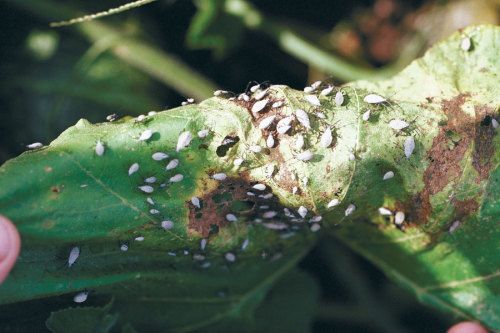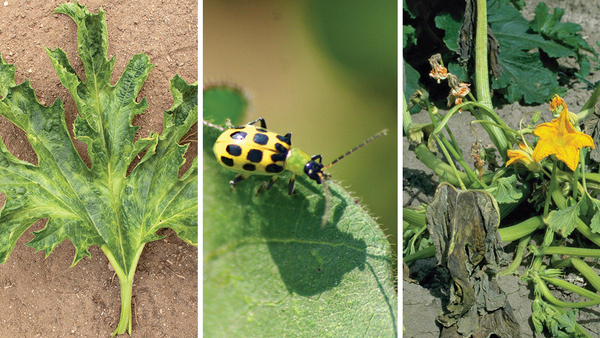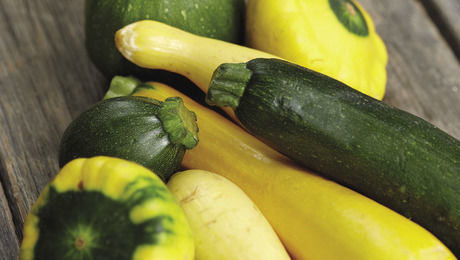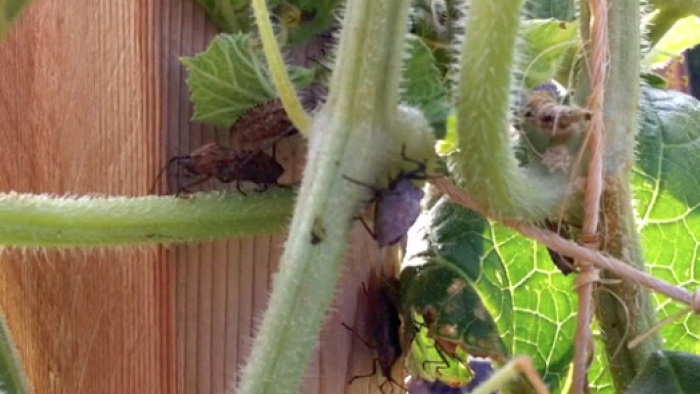
Now here is a bug you literally have to kneel down to. The adults and their eggs are found close to the ground. When you monitor for damage in your garden, which we urge you to do on a regular basis, you can suspect squash bug presence when small specks develop on the leaves of squash and other members of the cucurbit clan. These marks may be yellow at first but soon turn brown. The plant may wilt from the point of attack to the end of the vine, turning black and brittle. Very young plants may be killed entirely.
Insect predators and prevention keep squash bug numbers under control. The squash bug is found throughout most of the United States, but may be less of a pest wherever its natural enemies are native, as in the eastern United States, or where they have been deliberately introduced and established. The beneficial tachinid fly, imported in the 1940s, parasitizes the squash bug in a wide area ranging from New Jersey into the state of Washington. Recently, the same natural enemy has been successfully established in parts of northern California. But if you don’t live where natural enemies are sufficient to suppress the squash bug population, or if you grow the plants it loves the best, what can you do?
Luckily there are ways you can reduce the local population of this insect before it reaches epic proportions. Adult bugs winter over in garden debris, so the first step is autumn cleanup in the garden to remove the habitat needed for winter survival. Thoroughly rake up all garden debris and leaves where squash has been grown and extend the cleanup to adjacent beds and border areas. Plants with lots of live bugs and egg masses should be stuffed into plastic bags, closed securely, and set in the sun until the debris has decomposed. Place other garden debris into a hot compost pile. Remove and stack any boards used to trap squash bugs (more on this later).
Leave the raked ground bare of mulch for several weeks of cold weather. This deprives squash bugs of the protection they need to survive cold temperatures, and they die. At this point, it’s safe to spread a fresh layer of compost or other organic material over garden beds to decompose and be worked into the soil prior to spring planting.
Stick with less susceptible varieties and protect young plants. Scientific studies reveal that some plants are more attractive to squash bugs than others. Zucchini and cucumber seem fairly resistant to infestations, as do various types of muskmelon and watermelon. Pumpkin and summer squash, such as yellow crookneck and straightneck, are particularly susceptible. Skip growing these if you are overwhelmed with squash bugs each year and our other suggestions for suppression do not help enough.
Remember, the first squash bugs of the season will come into your garden as adults from wherever they spent the winter. If you can exclude them from the beds with row covers until plants are old enough to tolerate a little damage, you’ve won half the battle. However, when the squashes flower, you’ll have to uncover them for pollination by flying insects.
We’ve learned from experience that spending a little more and getting a tougher material for row covers pays off. The best fabrics last three or four years and can be mended with clear packing tape by covering both sides of rips or holes. Sew two pieces of row cover together if you can’t buy it wide enough for your needs. Place it over hoops made of strong wire—we use #9 gauge—cut in lengths long enough to give you the height needed when the wire is bent over and the ends inserted at least 4 in. into the soil. If you have a windy site, position a second wire over the top of the fabric and rest it on the wire underneath to sandwich the fabric between the wires. Bury the bottom edges of the row cover fabric under soil or mulch to prevent insects from crawling under the barrier.
Trap bugs or hand-pick them. Insects are strongly influenced by temperature, and squash bugs can run fast when it is hot. Luckily, squash bugs are comparatively large insects, so it’s easy to hand-pick adults in the cool hours of the day.
While the plants are young and still covered with row covers, place boards on the ground near the beds of squash to trap bugs migrating into the garden. Early or late in the day, turn over the boards, pick off the bugs by hand, and drop them into a jar of soapy water.
When you remove the row cover to allow pollination, it’s time to start monitoring plants for both adults and egg masses. You will find adults around the base of the plant, and hiding in rough debris on the bed surface. Eggs are laid on stems and on the undersides of leaves, often in the spaces where two veins come together. The eggs are orange-bronze, elliptical, and laid on their sides in small groups. Use a gloved hand or a flat stick to crush them. Young nymphs hatch a week or two after eggs are laid. The adults continue to lay eggs until midsummer.
Avoid coarse mulches that give bugs a place to hide. Compost mulches are critical, especially in arid climates like ours in California. They hold in moisture and keep soil temperatures moderate and weeds down. However, studies on squash bugs have shown that any type of mulch, even light or dark plastic mulches, increase squash bug problems because mulches give the insects a place to hide.
So in this case, we recommend creating a very smooth, finely broken up soil surface and leaving it bare. Count on the row cover to hold in moisture while plants are small. By the time you remove the cover, plants should be large enough to shade the ground. As the large lower leaves begin to wither and die, cut them off, crush any egg masses, and put them in a hot compost pile.
Insecticidal soap and homemade sprays work. Insecticidal soap is effective against adult squash bugs, but not against eggs, so you must still crush those by hand. Also, household soap combined with mineral oil and minced garlic is reported to be effective by the Henry Doubleday Research Association in England. Its formula is 3 ounces of chopped garlic, soaked in 2 teaspoons of mineral oil for 24 hours, added to a pint of water with 1⁄4 ounce of soap. Strain before using.
Rodale’s garlic spray is one bulb of garlic, one small onion, 1 teaspoon of cayenne pepper powder mixed with a quart of water. After soaking for an hour, add a tablespoon of soap and mix well. These homemade sprays are described in Rodale’s Chemical-Free Yard & Garden, edited by Anna Carr and Fern Marshall Bradley, Rodale Press, 1995.
Forget about really squashing squash bugs. These insects give off an unpleasant odor when squashed, bad enough that some people call them stink bugs, a term applied to a variety of insects. Crush the eggs, but pick up the bugs intact and drop them into detergent and water. When they are dead, put them into a hot compost pile. Or capture them with a hand-held, battery vacuum with strong suction. If all this sounds like too much work, ask around in your neighborhood about squash varieties that don’t have squash bug problems, and stick to growing those.
by Helga Olkowski
October 1997
from issue #11


















Comments
Log in or create an account to post a comment.
Sign up Log in